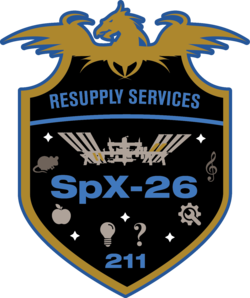 Launch of CRS-26 | |
| Names | SpX-26 |
|---|---|
| Mission type | ISS resupply |
| Operator | SpaceX |
| COSPAR ID | 2022-159A |
| SATCAT no. | 54371 |
| Mission duration | 45 days, 14 hours, 59 minutes |
| Spacecraft properties | |
| Spacecraft | Cargo Dragon C211 [1] |
| Spacecraft type | Cargo Dragon |
| Manufacturer | SpaceX |
| Dry mass | 9,525 kg (20,999 lb) |
| Dimensions | Height: 8.1 m (27 ft) Diameter: 4 m (13 ft) |
| Start of mission | |
| Launch date | 26 November 2022, 19:20:42 UTC [2] |
| Rocket | Falcon 9 Block 5 B1076-1 |
| Launch site | Kennedy Space Center, LC-39A |
| End of mission | |
| Recovered by | MV Megan |
| Landing date | 11 January 2023, 10:19 UTC [3] |
| Landing site | Gulf Of Mexico |
| Orbital parameters | |
| Reference system | Geocentric orbit |
| Regime | Low Earth orbit |
| Inclination | 51.66° |
| Docking with ISS | |
| Docking port | Harmony zenith |
| Docking date | 27 November 2022, 12:39 UTC |
| Undocking date | 9 January 2023, 22:05 UTC |
| Time docked | 43 days, 9 hours, 26 minutes |
 SpaceX CRS-26 mission patch | |
SpaceX CRS-26, also known as SpX-26, was a Commercial Resupply Service mission to the International Space Station (ISS) launched on 26 November 2022. [2] The mission was contracted by NASA and flown by SpaceX using a Cargo Dragon. This was the sixth flight for SpaceX under NASA's CRS Phase 2 contract awarded in January 2016.





